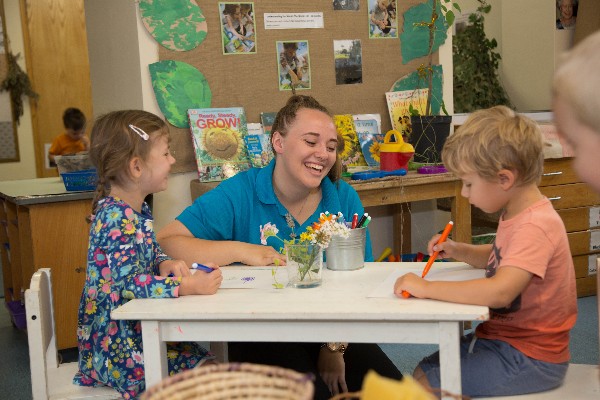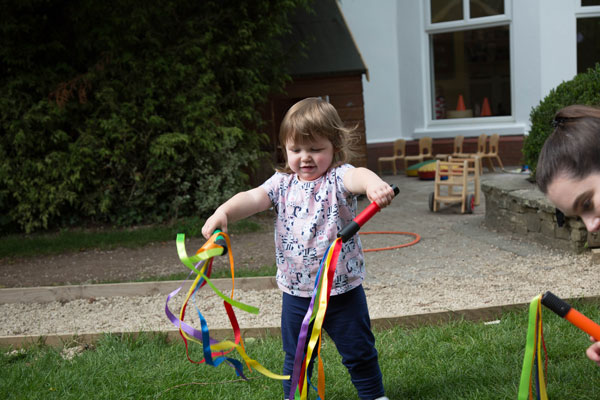
Let’s explore what mark-making is and how you can support your child to develop the early skills needed to start writing and develop mathematical understanding, creative expression, art, and drawing.
Children love to imitate adults and will use a wide variety of tools and resources to make marks, these early ‘scribbles’ are an important part of children developing the necessary hand-eye coordination needed for handwriting. For young children mark-making is a sensory experience, it is as they develop they begin to understand that marks can carry meaning.
Children start to make marks from the time they can control the movements of their hands and feet, whether that is swishing food around on their tray or picking up a crayon, pressing it down, and watching colour appear on the nearest clean surface.
Learning to hold a pencil and make marks that ultimately lead to writing is a complex development. Children move through stages in their mark-making, initially, it is a physical activity. It starts with large movements using the shoulder, wrist, hand, and then fingers. The child grasps tools with their whole hand, moving their arm from the shoulder, over time this becomes more refined until children can hold a pencil between their thumb and index finger.
Children of all ages make marks to explore textures, feelings, to express themselves, and make sense of the world, before and alongside using symbols to convey and represent messages. Mark-making takes place inside and outside.
How can you support mark-making?
Talk to your child about the marks they make, ask them what they are doing, and describe what you can see, this will indicate to your child that these marks are important and that you value them.
Value any mark-making your child may bring home from their setting and share any mark making your child has done at home with you.
What else can you do to support your child?
- Provide different kinds of mark-making materials e.g. ribbons, sponges, washing up brushes, toothbrushes, pegs with different things in them, glue spreaders, chunky crayons, chalks, ‘bingo dabbers’, cars, paint rollers, brushes, felt pens, cardboard tubes, paint, feathers, combs, sticks
- Provide different kinds of material in different sizes and shapes for children to make marks on e.g. wallpaper, newspaper, leaves, material, plain paper, paper with lines and squares, textured paper, card
- Marks can be made in all sorts of media, for example, clay, sand, soil, as well as on different types and colours of paper. Remember too that cutting and sticking is another way that your child can make their mark.
- Peg a piece of paper to a fence and paint with spray bottles filled with watered-down paint.
- Put some water in a paint tray and use a roller to make big marks on a sunny wall or patio
- Put some paint in a tray, roll cars through it, and then roll them on paper
- Have a bucket of water with large brushes, and a selection of sponges for mark-making on hard ground outside or walls.
- Use large chalks for making marks on the tarmac.
- Gather seasonal natural materials to inspire mark-making, for example, leaves, seedpods, fir cones, dried flowers. Do leaf rubbings, flower pressing, and collages. Try using flowers and twigs as mark-making tools and brushes.
- Strengthen the muscles in your child’s arms and hands by providing activities such as playdough, threading, picking up small objects, making shapes in the air with a wand, and dancing with a ribbon in their hand.
- Attach pens to toy trucks and roll them around on paper
- Cut small holes in rubber gloves, or make small holes in a container e.g. yogurt pot, fill them with paint and let it drip onto paper
- Line a tin that has a lid with paper, roll a ball, or marble in paint. Put it in the tin, put the lid on and shake.
- Ice cakes and biscuits, letting your child explore the different colours and how the icing blends together.
- Cover a flat tray with either sand, salt, shaving foam, or sugar. Use fingers and combs to make marks with.
- Roll a ball in paint and then bounce it onto paper.
- Children just love messy activities – explore mark-making using materials such as jelly, shaving foam, cornflour and water, and wallpaper paste.
- Share with your child the importance of print, that words on food packets and street signs as well as numbers and letters on car registrations and buses all carry meaning.
Always remember to supervise your child carefully, and be aware of what they might put into their mouths. Most of all, enjoy mark-making together!

